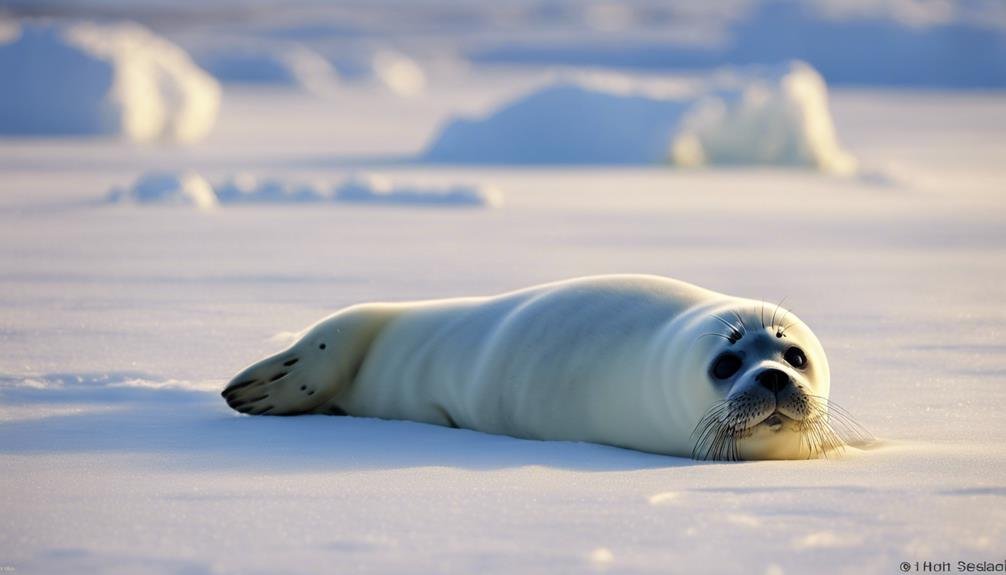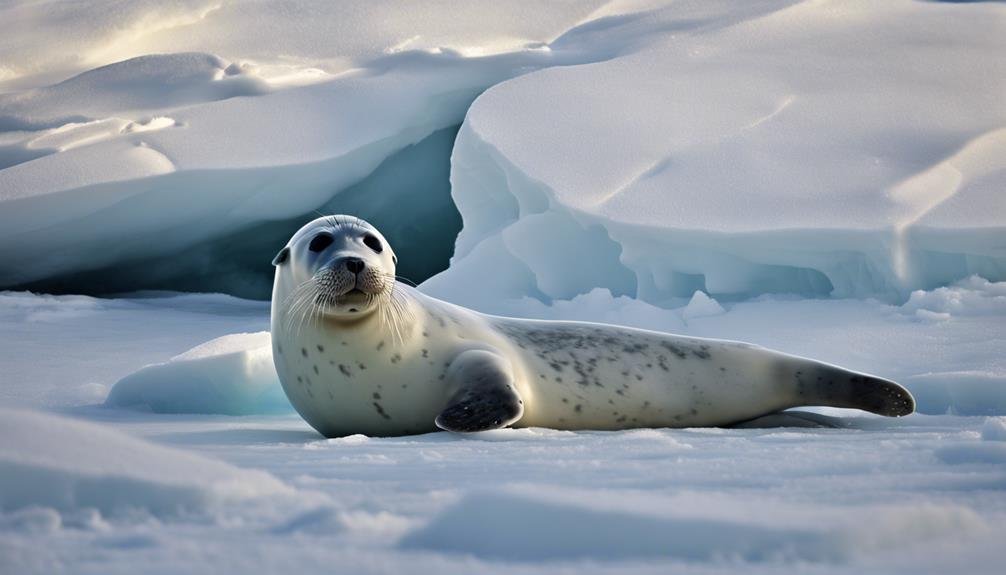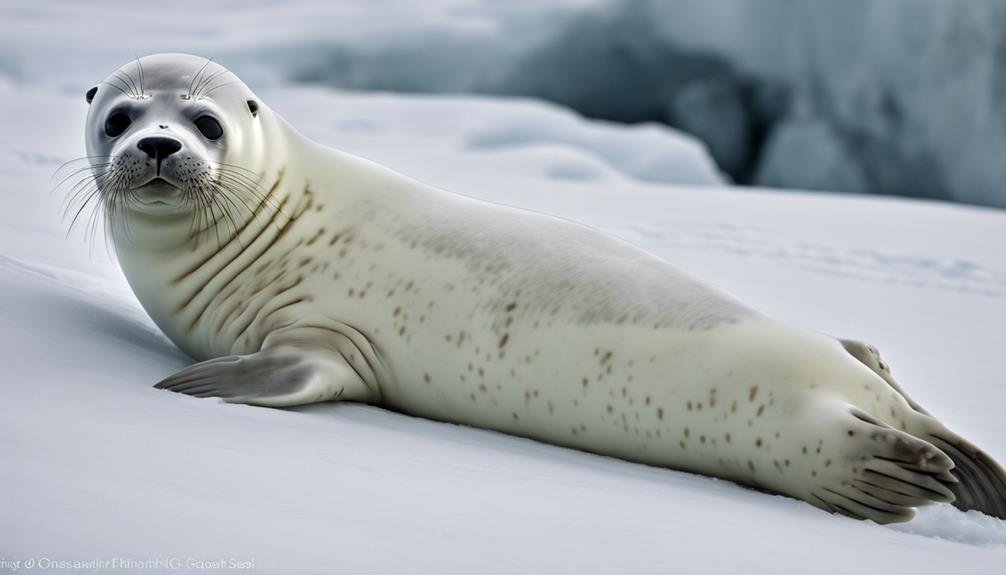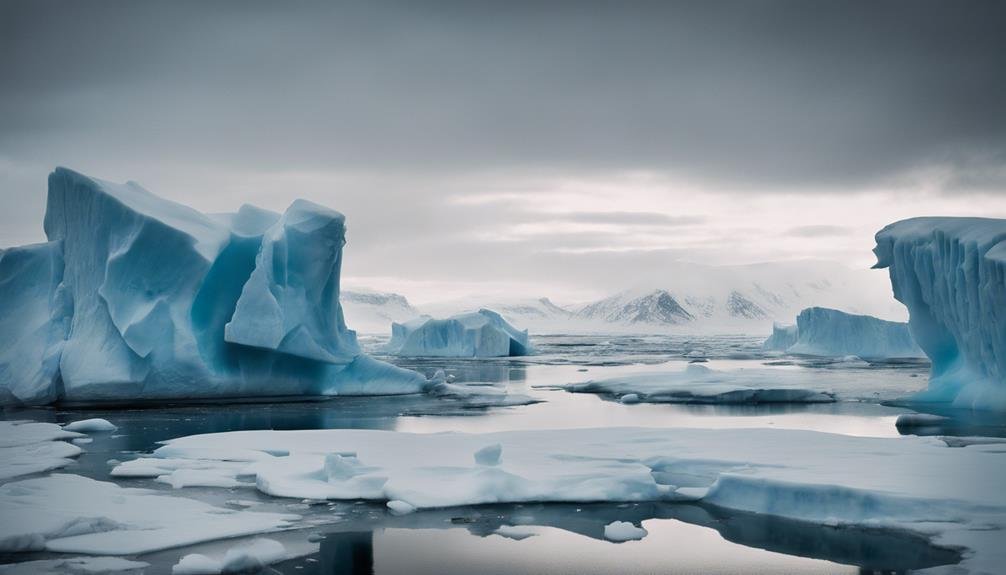Why are ringed seals considered so vital to the Arctic marine ecosystem? These resilient creatures, adept at navigating and surviving in one of the harshest environments on our planet, play a pivotal role in maintaining the ecological balance of their habitat. Their ability to carve breathing holes through thick ice with their sharp claws is not just a testament to their resourcefulness but also a key survival mechanism in the extreme Arctic conditions.
Ringed seals are a cornerstone species in the Arctic, contributing significantly to its biodiversity. These seals are not only prey for larger predators like polar bears and killer whales but also contribute to the marine food web through their diet of fish and invertebrates. The challenges they face, such as climate change and habitat destruction, have implications not just for the seals themselves but for the entire Arctic ecosystem.
The rapid melting of sea ice, a direct consequence of global warming, threatens the very foundation of their existence, highlighting the urgent need for conservation efforts. Protecting these seals is not just about preserving a single species but about safeguarding the Arctic marine ecosystem as a whole.
Key Takeaways
Ringed seals possess adaptations such as creating breathing holes and deep diving, which enable their survival in the Arctic environment. These adaptations highlight their exceptional survival strategies in extreme conditions.
The loss of habitat and climate change pose significant threats to the ringed seals’ existence. This information underscores the urgency of addressing environmental challenges to ensure their survival.
Ringed seals are solitary animals, only coming together for breeding and molting, indicating complex behaviors and strong territorial instincts. This aspect of their life illustrates their unique social structure and the importance of understanding their behaviors for conservation efforts.
Protective measures are crucial for the survival of ringed seals, emphasizing the need for research and actions against climate change. This point stresses the importance of human intervention in mitigating the challenges faced by these seals.
Scientific Classification
Kingdom: Animalia
The ringed seal starts its classification journey in the Kingdom: Animalia, indicating it’s a complex, living entity composed of cells with nuclei. This kingdom encompasses a vast array of life forms, all sharing the fundamental characteristic of being able to respond to their environment in varied and fascinating ways.
Phylum: Chordata
Moving down the hierarchy, the ringed seal finds its place in the Phylum: Chordata. This classification underscores the presence of a notochord – a flexible rod that provides support – during some stage of the animal’s life cycle. It’s a distinguishing feature that links the ringed seal to a broad group of animals, from simple sea squirts to complex mammals.
Class: Mammalia
Within the Class: Mammalia, the ringed seal shares key traits with other mammals, such as the presence of mammary glands for feeding their young and fur or hair that offers insulation. This class highlights the adaptability and diversity of mammals, enabling them to inhabit environments from the deepest oceans to the highest mountains.
Order: Carnivora
The Order: Carnivora signals the ringed seal’s carnivorous diet, a characteristic it shares with a diverse group of both predators and scavengers. This order includes animals equipped with specialized teeth for slicing, tearing, or grinding flesh, reflecting the varied dietary strategies that have evolved among carnivores.
Family: Phocidae
As a member of the Family: Phocidae, the ringed seal is recognized as a true seal, characterized by its lack of external ear flaps and a streamlined body designed for efficient aquatic life. This family distinction sheds light on the unique adaptations seals have developed to thrive in marine environments.
Genus: Pusa
The Genus: Pusa specifically identifies the ringed seal among other seal species. This level of classification is crucial for understanding the genetic and morphological nuances that distinguish the ringed seal from its close relatives, providing insight into their evolutionary history.
Species: P. hispida
Habitat

Ringed Seal Habitats: A Cold Water Realm
Ringed seals make their homes in the icy waters of the Arctic seas and the North Pacific Ocean. These cold environments are critical for their existence, providing safe havens from predators and necessary conditions for their life processes. The presence of ice, in particular, is vital for their breeding, molting, and resting phases, marking these regions as indispensable for ringed seal populations.
Adaptability Across Latitudes
Despite the harsh conditions, ringed seals exhibit remarkable adaptability. Their habitats extend into the temperate zones of the North Pacific, reaching areas as far south as Japan. This broad geographical distribution demonstrates their ability to thrive in a range of cold marine environments, from the ice-bound Arctic to the cooler waters of the northern Pacific.
The Threat of Climate Change
The ongoing threat of climate change poses a significant risk to the habitats of ringed seals. The accelerated melting of sea ice compromises their breeding grounds, potentially destabilizing their populations. This environmental challenge underscores the importance of addressing global warming not only for the sake of human communities but also for the preservation of species like the ringed seal, which depend on the ice for survival.
Conservation Efforts: Protecting Icy Sanctuaries
Preserving the icy habitats of ringed seals is fundamental to ensuring their survival. Conservation initiatives aimed at mitigating the effects of climate change and safeguarding these marine environments are crucial. The fight to protect ringed seals from the brink of endangerment is intrinsically linked with broader environmental conservation efforts, highlighting the interconnectedness of global ecosystems.
Diet

Ringed Seals and Their Arctic Diet
Adapting to Icy Habitats
Ringed seals thrive in the cold Arctic, feeding mainly on fish and crustaceans. Their remarkable ability to adjust their eating habits ensures they can survive the challenging conditions of their environment. The diet of these seals is key to their growth and development through various life stages.
Diet Variation Among Young Seals
Young ringed seals have a diet that’s rich in crustaceans, differing from that of adult seals. This variation is important for fulfilling the specific nutritional requirements during their growth phase. The diet of ringed seals shows flexibility:
- Core diet components include fish and crustaceans.
- Young seals consume more crustaceans.
- Food source availability influences what they eat.
- A reduction in food intake is observed during the spring molt.
- Life stage dictates the dietary needs to support growth and development.
The ability of ringed seals to alter their diet based on available food sources highlights their resilience in the Arctic’s extreme conditions. Their dietary habits are a testament to their adaptability, ensuring their survival and well-being in the icy habitats they call home.
Behaviour

Ringed Seals: Seasonal Behaviors and Social Dynamics
Ringed seals, known for their usually solitary behavior, show fascinating adaptations to their surroundings and biological cycles. Let’s delve into how these creatures adjust their lifestyles in response to mating, molting, and the need for territory and food.
Seasonal Shifts in Social Interactions
During the mating season, we witness a remarkable transformation in ringed seal behavior. These animals, typically seen hunting and resting alone, start forming groups. They create lairs in close proximity, a clear indication of their social side coming to the forefront to meet reproductive demands.
Mating Season: A Time for Togetherness
This period is characterized by increased social interactions among ringed seals. The formation of group lairs signifies a temporary yet significant shift from their usual solitary existence. It’s a time when the need for reproduction overshadows their preference for solitude, showcasing the seals’ ability to adapt their social behaviors.
Adaptations for Molting
Molting, another critical season, sees a slight shift in their solitary nature. Ringed seals tend to rest together in groups during this time, seeking warmth and perhaps a sense of security in numbers. This behavior underlines the dynamic nature of their social interactions, driven by specific biological needs.
Territorial Vigilance and Hunting
Despite these seasonal shifts towards more social behavior, ringed seals fiercely guard their lairs and breathing holes. This territorial behavior is essential for their survival, providing safe havens from predators and ensuring access to the water beneath the ice. When hunting, they revert to their solitary ways, demonstrating their efficiency and skill as lone predators.
Conservation

Climate Change Mitigation for Arctic Habitats
Ringed seals face the challenge of surviving in rapidly changing Arctic conditions, primarily due to the effects of climate change. Efforts to mitigate these changes are crucial in slowing the decline of Arctic sea ice, a habitat critical for the seals. By reducing greenhouse gas emissions and implementing sustainable environmental practices, we can help safeguard the icy home of ringed seals.
Snow Den Conservation Initiatives
A unique aspect of ringed seal survival revolves around the use of snow dens for their pups. These natural nurseries offer protection against predators and harsh weather. Protecting these vital structures involves monitoring snowfall patterns and ensuring that human activities don’t disturb these critical habitats.
Policy and Restoration to Counter Habitat Loss
The battle against habitat loss for ringed seals involves a combination of policy measures and direct action. Through the creation of protected areas and the restoration of damaged ecosystems, we can provide ringed seals with the environments they need to thrive. This approach requires collaboration between governments, conservation organizations, and local communities.
Population Monitoring for Informed Strategies
Understanding the current state of ringed seal populations is key to effective conservation. Regular monitoring efforts provide valuable data on population sizes, health, and trends. This information is essential for crafting targeted conservation strategies and evaluating the success of ongoing efforts.
Awareness Campaigns for Arctic Conservation
Educating the public about the ringed seals’ plight and their role in the Arctic ecosystem is vital for garnering support for conservation efforts. Awareness campaigns can highlight the challenges faced by these animals and the ways in which individuals can contribute to their preservation.
Through these concerted efforts, we can make significant strides in preserving ringed seal populations and maintaining the balance of the Arctic ecosystem.
Climate Change Impacts

The Arctic Predicament: Shrinking Habitats for Ringed Seals
The effects of climate change are especially pronounced in the Arctic, where the habitat of ringed seals is undergoing dramatic transformations. The loss of Arctic sea ice isn’t just a statistic; it directly impacts these marine mammals’ ability to find safe breeding and molting areas. Without these crucial habitats, the entire lifecycle of ringed seals, from birth through to maturity, is being upended.
The Struggle for Food and Safety Amidst Thinning Ice
As sea ice retreats, ringed seals face heightened challenges in accessing their prey, which significantly affects their survival rates. This scarcity of food is compounded by a closer proximity to predators. The changing geography of the Arctic ice means ringed seals have fewer places to hide and are more likely to encounter threats from predators, making their survival even more precarious.
Conservation Efforts: A Beacon of Hope
In response to these significant challenges, conservation initiatives are stepping up to address the root causes and impacts of climate change on ringed seals. The goal of these efforts is to stabilize and eventually increase the expanse of Arctic sea ice, offering ringed seals a fighting chance at survival. Through targeted conservation actions, there’s hope for mitigating the adverse effects of climate change on these vulnerable marine populations.
Other Interesting Facts
Exploring the Fascinating World of Ringed Seals
Delving into the Arctic’s icy expanses, ringed seals present an array of intriguing behaviors and adaptations that underscore their mastery of this frigid environment. These marine mammals have developed remarkable strategies to navigate the perils and exploit the opportunities of their polar habitat.
Innovative Breathing Techniques
Ringed seals have perfected the art of maintaining cone-shaped holes in the thick ice. This ingenious method ensures they can surface for air even during their extensive dives beneath the ice.
Intelligent Defense Mechanisms
To evade their primary predator, the polar bear, ringed seals have adopted a unique strategy. They blow bubbles through their breathing holes as an early warning system to detect any threats lurking above.
Preference for Solitude
Although ringed seals are mostly solitary animals, they exhibit a strong sense of territoriality. This is particularly evident around their carefully maintained lairs and breathing holes, which are crucial for their survival.
Adapted for the Depths
Their ability to perform dives up to 300 feet deep, remaining submerged for as long as 45 minutes, is a remarkable feat. This not only showcases their physical adaptations but also their skill in hunting for food in the depths of the Arctic waters.
Social Interactions on Ice
Despite their solitary nature, there are times when ringed seals come together. These seasonal gatherings on the sea ice for breeding, molting, and resting highlight a delicate balance between their independence and the occasional need for social interaction.
Through these unique characteristics, ringed seals have become adept at not just surviving but thriving in one of the harshest climates on Earth. Their lifestyle and adaptations offer a window into the resilience and complexity of Arctic marine life.
Are Ringed Seals and Harp Seals Related Species?
Ringed seals and harp seals are not closely related species. Ringed seals belong to the Pusa genus, while harp seals belong to the Pagophilus genus. Learn about harp seals to understand their distinct differences from the ringed seals. Both species have their own unique habitats and behaviors in the wild.
Frequently Asked Questions
What Are Some Interesting Facts About Ringed Seals?
Q: Where do ringed seals live?
A: Ringed seals predominantly reside in the Arctic region, thriving in its cold waters.
Q: What are the distinctive features of ringed seals?
A: These seals are known for their distinctive markings on their coats, resembling rings, and their ability to breed on ice.
Q: How do ringed seals communicate?
A: They are vocal communicators, using a variety of sounds to interact with one another.
Q: What threats do ringed seals face due to climate change?
A: Climate change poses a significant threat by melting their ice-dependent habitats, impacting their ability to breed and find food.
Q: How do ringed seals rear their pups?
A: They have specific pup rearing practices, including creating protective lairs in the ice for their young.
Q: Do ringed seals migrate?
A: Yes, ringed seals exhibit migration patterns, moving in response to the seasonal melting and freezing of Arctic ice.
How Long Do Ringed Seals Live?
Q: How long do ringed seals typically live?
A: Ringed seals usually have a lifespan of 25-30 years in their Arctic habitats. Factors such as breeding cycles, dependence on ice, and predation significantly affect their longevity and, consequently, their population and conservation status. They utilize vocal communication within their social groups.
What Fish Do Ringed Seals Eat?
Q: What types of fish do ringed seals typically eat?
A: Ringed seals primarily consume Arctic cod, herring, and capelin. Their diet varies with the seasons and their nutritional requirements, reflecting the diversity of their Arctic habitat.
How Deep Can a Ringed Seal Dive?
How Deep Can a Ringed Seal Dive?
Q: What is the maximum depth a ringed seal can reach during a dive?
A: A ringed seal is capable of reaching depths of up to 300 feet when diving. This ability is attributed to their specialized dive physiology that includes efficient oxygen management and adaptation to high pressure. These seals employ specific behaviors like using ice features for breathing and strategies to avoid predators, which play a crucial role in their underwater survival. The duration of their dives and the time they require to recover afterwards can vary depending on the season.
Conclusion
Ringed seals demonstrate impressive adaptations that enable them to thrive in the extreme conditions of the Arctic. Their ability to create sophisticated breathing holes and their proficiency in deep diving stand out as remarkable survival strategies.
However, their existence is increasingly threatened by the loss of habitat and the impacts of climate change. These seals typically lead solitary lives, coming together only for pivotal times such as breeding and molting, which underscores their complex behaviors and strong territorial instincts.
Protecting these creatures is imperative for their continued survival. It underscores the importance of conducting detailed research and taking action against climate change to address the challenges they encounter.


